The RX 470 arrived last week at BTR for evaluation as a 4GB Red Devil video card from PowerColor. This review is not supposed to be of the reference 4GB RX 470 at stock 1206MHz Boost clocks, but at PowerColor 1270MHz clocks. Unfortunately, the BIOS that came with the PowerColor Red Devil had clocks that were completely locked down at the reference RX 470 speeds and it wouldn’t overclock at all. PowerColor finally came through with a new BIOS that was unfortunately too late for this review. What you will see in this evaluation is a PowerColor RX 470 Red Devil running at reference RX 470 speeds, and we will have a follow up review later that will show the Red Devil’s true performance, as well as manually overclocked performance.
AMD released its new Polaris architecture as the RX 480 on June 29, and we compared the reference 8GB version to the GTX 980, to a mildly overclocked 970, and to the reference 290X and to the XFX 390 OC. We saw that even though it launched on immature drivers and with power issues, it is definitely well-suited for bringing less expensive VR to the masses as AMD claims. We followed its progress with improved drivers that somewhat addressed the power issues, and we also saw that it was only a fair overclocker versus the GTX 1060.
Now we have a brand new card released today from AMD, the RX 470, in the form of the PowerColor Red Devil that we will benchmark at reference RX 470 speeds against the reference RX 480 to see how it compares in performance. And we will also benchmark competing cards to see where the new card stands regarding price versus performance.
According to AMD, the RX 480 is differentiated from the RX 470 graphics card by the RX 480’s superior ability to deliver immersive VR experiences with leading VR headsets whereas the RX 470 is aimed primarily at desktop PC gaming. However, both the RX 480 and the RX 470 feature asynchronous shaders and new geometry capabilities that enable support for DirectX 12 and Vulkan with the latest version of Graphics Core Next (GCN) for PC gamers. And gamers will be able to stream and record their favorite games up to 4K at 60 FPS with virtually no performance impact.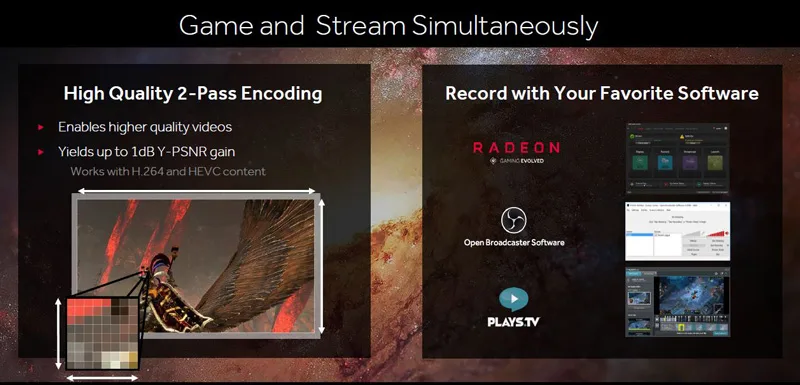
Polaris architecture combines the latest FinFET 14 process technology and advanced power, gating, and clocking technologies to deliver a cool-and-quiet gaming experience compared with their last generation. Polaris boasts a brand new display engine and HDR-ready capabilities while the new Radeon WattMan (formerly AMD Overdrive) offers a new level of customization and control over clocks, voltages, and temperature. And as with previous generations, Radeon software tends to optimize the hardware as drivers mature, improving gaming performance over time.
Instead of requiring 2 PCIe connectors as in the 28nm R9 200 and 300 series, the RX 480 and the Red Devil RX 470 get by with only 1, yet they are supposed to deliver near R9 390 performance. In the case of the PowerColor Red Devil RX 470, it uses a single 8-pin PCIe cable versus the 6-pin power connector in the reference RX 470 and RX 480. And we saw the RX 480 get into trouble with its 6-pin connector as being insufficient for overclocking. Having an 8-pin power connector plus superior 6+1 multi-phases where each phase supplies 25W instead of 22.5W found in the reference board, the Red Devil RX 470 is designed for superior performance, overclocking, and more stable power.
New Features for Polaris
Make sure to check the RX 480 8GB launch article which gives even more details about Polaris’ new features. The following is a summary.
WattMan
 To accompany the new Polaris architecture, Radeon WattMan is AMD’s new overclocking utility that controls GPU voltage, engine clocks, memory clocks, fan speed and temperature. And WattMan even features data capture and a historical view of GPU activity, temperature, fan, and clock speeds.
To accompany the new Polaris architecture, Radeon WattMan is AMD’s new overclocking utility that controls GPU voltage, engine clocks, memory clocks, fan speed and temperature. And WattMan even features data capture and a historical view of GPU activity, temperature, fan, and clock speeds.
Async Shaders is a feature that allows complex graphics tasks to use all available AMD Radeon graphics resources simultaneously. Breaking one big job into many small segments allows the work to be done more quickly, yielding greater performance. AMD’s Graphics Core Next architecture has dedicated hardware, called Asynchronous Compute Engines (ACE), which are specifically designed to do this job at high speed.
Let’s take a brief look at the specifications of the AMD Radeon RX 470 reference version versus the PowerColor Red Devil RX 470.
The reference RX 480 8GB vs. the Red Devil RX 470 4GB
With the RX 480, AMD wants to bring R9 390/GTX 970 performance into a much less expensive and less power-hungry card for gamers and for entry level VR. Much is made of Liquid VR for immersive Virtual Reality headsets which are already available this year. And FreeSync, DX12, Eyefinity, CrossFire and TrueAudio are featured for the Polaris RX 480 along with WattMan, AMD’s new overclocking utility.
First, here are the specifications for the RX 480: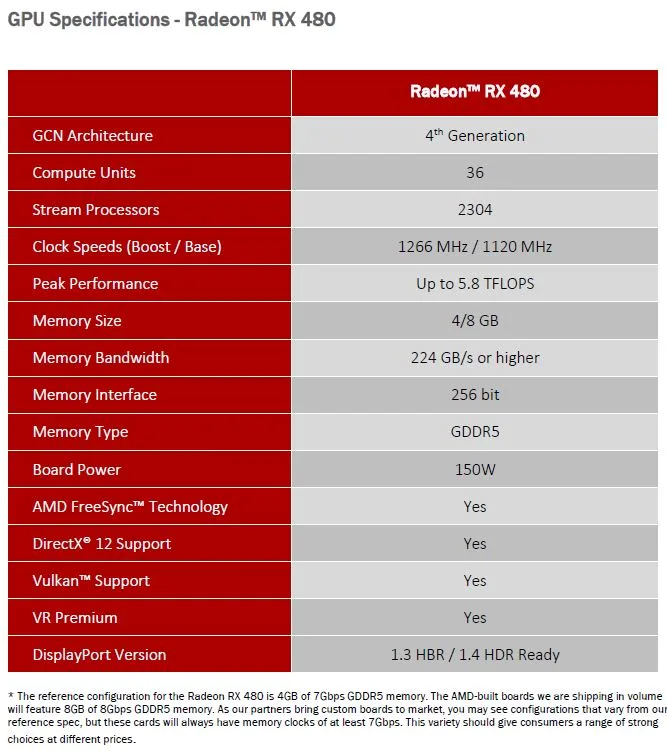
The above specifications are for the 8GB $239 version of RX 480 that we reviewed at launch which uses 8GB of 8Gbps GDDR5 memory. The $199 version of RX 480 uses 4GB of 7Gbps memory, and we have not tested it. This is the same memory that is used in the reference and Red Devil RX 470 4GB. Here are the specifications for the reference $179 RX 470: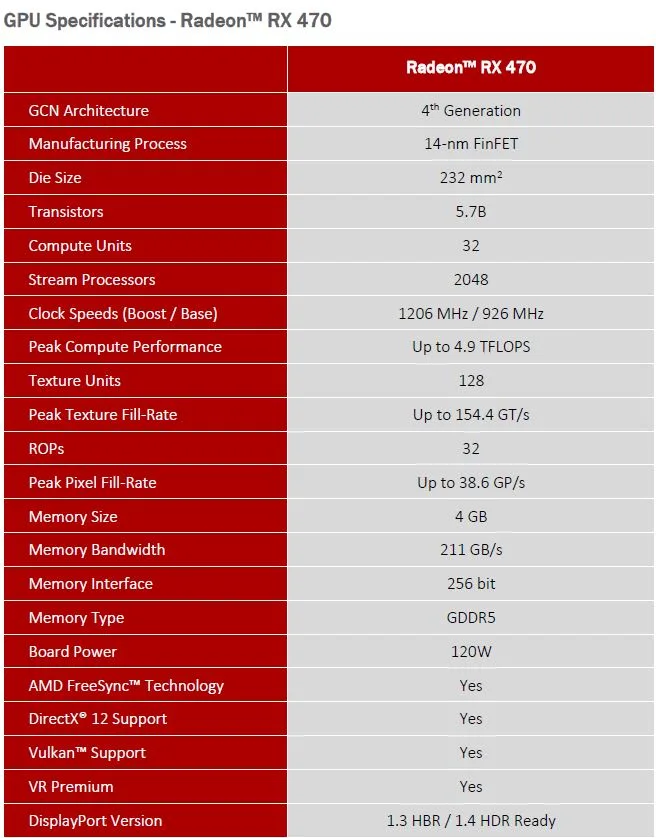
Now here are the specifications for the $199 PowerColor Red Devil RX 470: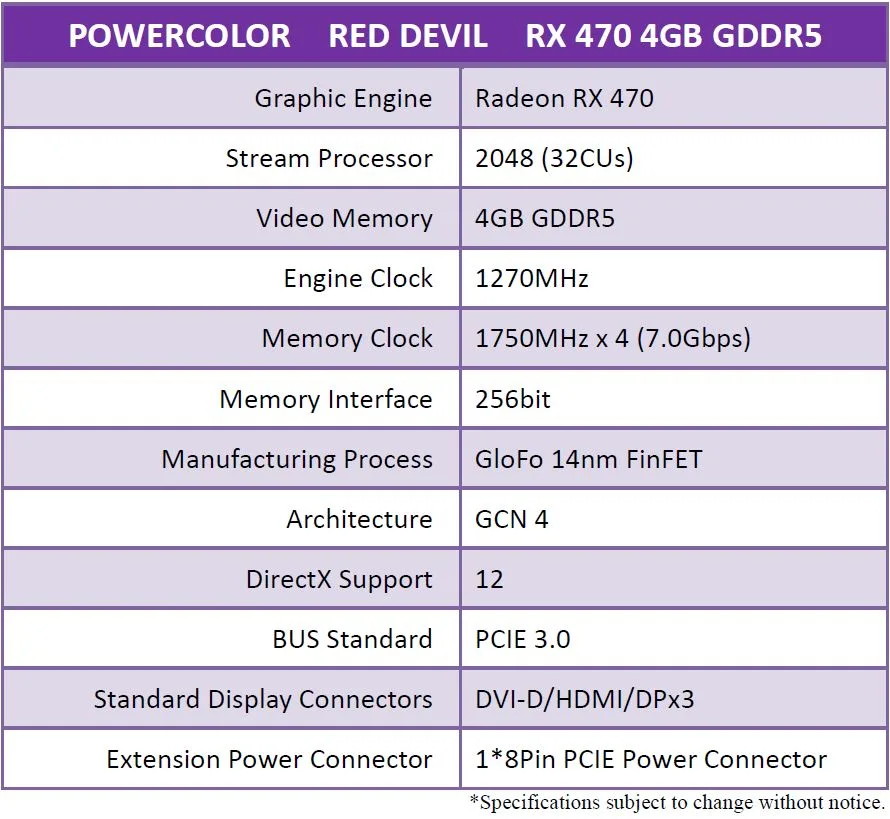
The specifications of the RX 470 are quite impressive for a $179 to $199 card, even compared to the more expensive RX 480. The Red Devil’s boost clocks have been increased from 1206MHz to 1270MHz, giving it near-parity with the RX 480 clocks. The main difference is that the RX 480 has 36 Compute Units while the RX 470 has 32.
Our Testbed of Competing Cards
Here is our testbed of 6 competing cards and we shall test 25 games and 2 synthetic benchmarks at 1920×1080 and at 2560×1440. Our testing platform is Windows 10 Home 64-bit, using an Intel Core i7-6700K at 4.00GHz which turbos to 4.4GHz for all cores as set in the ASRock Z7170 motherboard’s BIOS, and 16GB of G.SKILL DDR4 at 3000MHz.
- PowerColor RX 470 4GB – $199 – at RX 470 reference clocks; reference card is $179
- RX 480 8GB – reference version – $239 to $249
- PowerColor RX 280 3GB – no longer in stock; close to R9 380 performance – $150-$200
- ASUS Strix GTX 960 OC 2GB – $160-$200
- GTX 970 EXOC by GALAX, 4GB – $249
- GTX 1060 6GB, reference clocks, $249-$299
How does the RX 470 4GB compare with other similarly priced cards?
This is the big question: How does the RX 470 compare with other cards in a similar price to a higher price range?
First, let’s take a closer look at the new PowerColor Red Devil RX 480.
A Closer Look at the PowerColor Red Devil RX 470
Although the reference version doesn’t mention VR, the Red Devil RX 470 advertises itself as a card ready for both VR and gaming. Also, Vulkan and DX12 support, Liquid VR, 14nm and FreeSync are emphasized on the front of the box.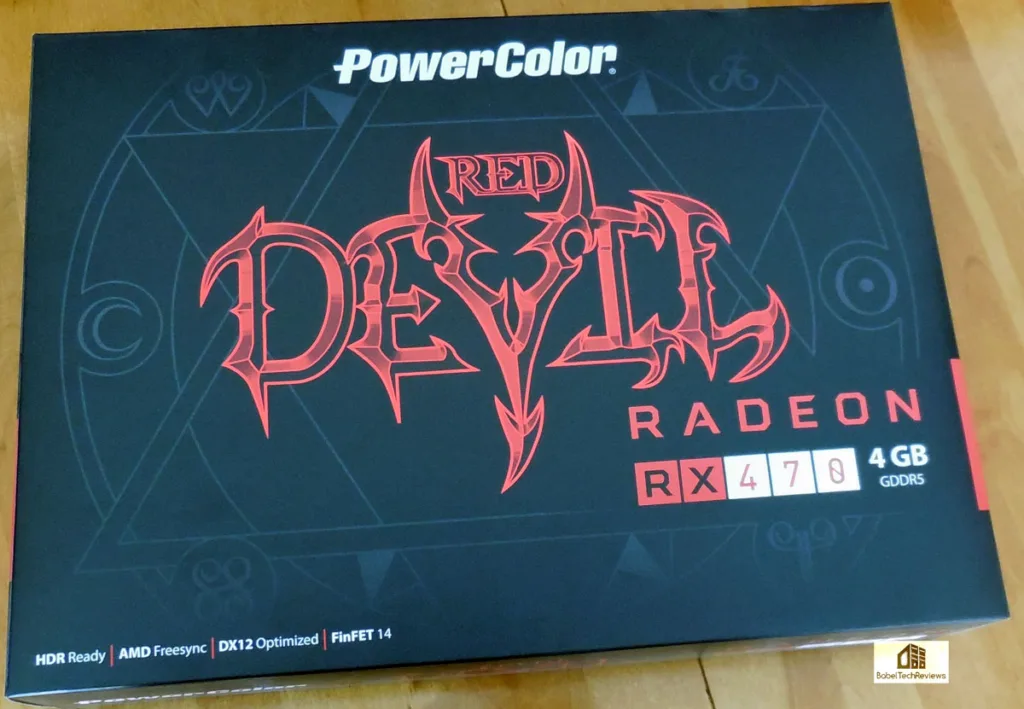
Here is the other side of the box showing the power and system requirements. There are two BIOS switches which can really be useful if you have a bad flash. The default left side is for performance and the right side is for silent gaming. Unfortunately for us, the left side performance BIOS was completely locked down, and we were forced to benchmark the card at stock RX 470 (1206MHz boost core) settings. PowerColor sent us an updated BIOS much too late for this review and we will follow up in about a week with both PowerColor clocks (1270MHz boost core) and overclocked performance (TBD) testing. The PowerColor Red Devil RX470 is a good looking and solidly built card with twin fan technology called Double Blade III which has more fan blades for increasing airflow and prevents dust deposits. The Double Blade III is made with dual 80mm 2-ball bearing fans to give what PowerColor claims is 4 times more longevity than regular fans
The PowerColor Red Devil RX470 is a good looking and solidly built card with twin fan technology called Double Blade III which has more fan blades for increasing airflow and prevents dust deposits. The Double Blade III is made with dual 80mm 2-ball bearing fans to give what PowerColor claims is 4 times more longevity than regular fans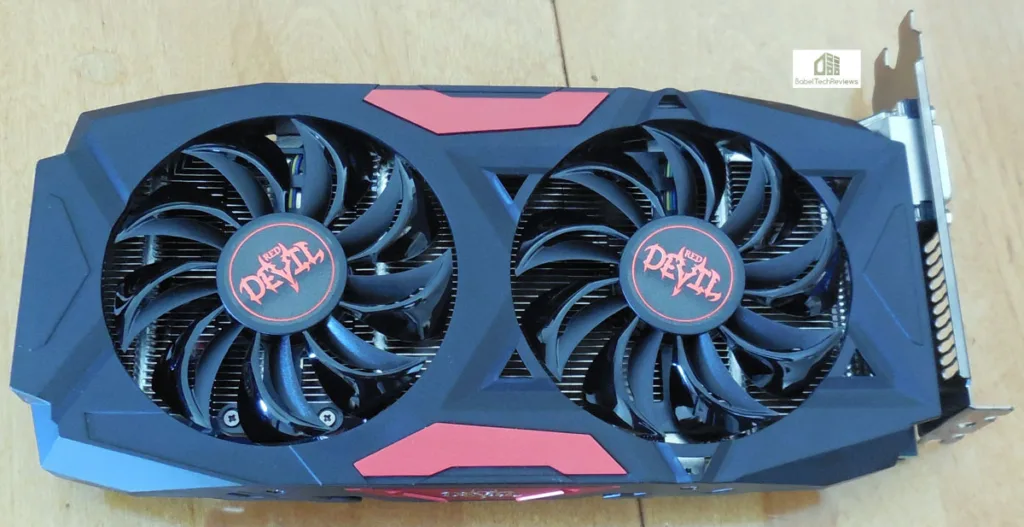 Turning it over, we see it is has a solid backplate.
Turning it over, we see it is has a solid backplate.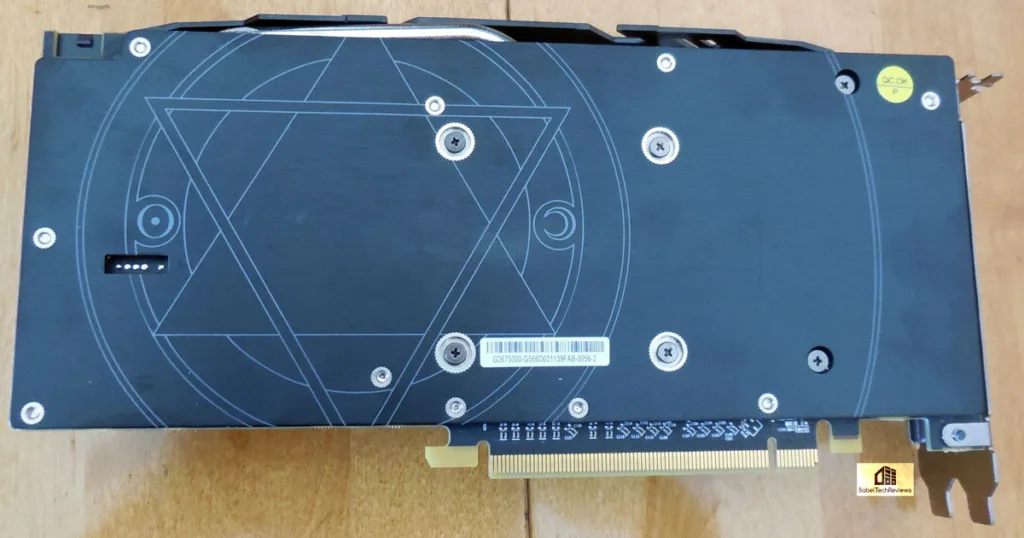
Very strangely, the PowerColor Red Devil card carries a hexagram inside a circle – a six-pointed star which is a symbol originating in Egypt and adopted as a symbol of the Jewish faith (“Star of David”; and as Donald Trump pointed out, could also be a “sheriff’s badge”). PowerColor’s hexagram in a circle has absolutely nothing to do with any Devil symbol or the associated modern occult Pentagram symbol which is always a similarly drawn 5-pointed star inside a circle.
The Red Devil’s RX 470 connectors include 3 DisplayPorts and 1 HDMI connection and a Dual-Link DVI connector. The reference versions of both the RX 470 and RX 480 lack the DVI connector.
The reference versions of the RX 470 and the RX 480 use only one 6-pin PCIe connector which got our reference RX 480 into trouble with power draw over the PCIe slot and also upset the stability of our PC when we tried to overclock it. On the other hand, PowerColor wisely uses an 8-pin power connector plus superior 6+1 multi-phases where each phase supplies 25W instead of 22.5W as in other cards for better stability and for better overclocking potential.
The specifications and the Red Devil RX 470 look good. Let’s check out its performance after we look over our test configuration on the next page.
Test Configuration – Hardware
- Intel Core i7-6700K (reference 4.0GHz, HyperThreading and Turbo boost is on to 4.4GHz; DX11 CPU graphics).
- ASRock Z7170M OC Formula motherboard (Intel Z7170 chipset, latest BIOS, PCIe 3.0/3.1 specification, CrossFire/SLI 8x+8x)
- G.Skill Ripjaws V 16GB DDR4 (2x8GB, dual channel at 3000MHz)
- PowerColor RX 470 4GB – $199 – at RX 470 reference clocks
- RX 480 8GB – reference version
- PowerColor RX 280 3GB, supplied by PowerColor
- ASUS Strix GTX 960 OC 2GB, supplied by ASUS
- GALAX GTX 970 EXOC, 4GB, supplied by GALAX
- GTX 1060 6GB, reference clocks,supplied by Nvidia
- Two 2TB Toshiba 7200 rpm HDDs for each platform
- EVGA 1000G 1000W power supply unit
- Thermaltake Water2.0, supplied by Thermaltake
- Onboard Realtek Audio
- Genius SP-D150 speakers, supplied by Genius
- Thermaltake Overseer RX-I full tower case, supplied by Thermaltake
- ASUS 12X Blu-ray writer
- Monoprice Crystal Pro 4K
Test Configuration – Software
- Nvidia’s GeForce 368.64 (GTX 1060 launch) drivers were used for Nvidia cards. High Quality, prefer maximum performance, single display.
- AMD Crimson Software 16.8.1 (RX 470 launch) drivers were used for the benching AMD cards
- VSync is off in the control panel.
- AA enabled as noted in games; all in-game settings are specified with 16xAF always applied
- All results show average frame rates including minimum frame rates shown in italics on the chart next to the averages in smaller font.
- Highest quality sound (stereo) used in all games.
- Windows 10 64-bit Home edition, all DX11 titles were run under DX11 render paths. Our four DX12 titles are run under the DX12 render path. Latest DirectX
- All games are patched to their latest versions at time of publication.
- Crimson Software’s WattMan was used for the RX 480/470. Overdrive was used for the other AMD cards
- EVGA’s Precision XOC, reviewer’s version 6 used for Nvidia cards.
The 26 PC Game benchmark suite & 2 synthetic tests
Synthetic
- Firestrike – Basic & Extreme
- Time Spy DX12
- Crysis 3
- Metro: Last Light Redux (2014)
- Middle Earth: Shadows of Mordor
- Alien Isolation
- Dragon’s Age: Inquisition
- Dying Light
- Total War: Attila
- Grand Theft Auto V
- ProjectCARS
- the Witcher 3
- Batman: Arkham Origins
- Mad Max
- Fallout 4
- Star Wars Battlefront
- Assassin’s Creed Syndicate
- Just Cause 3
- Rainbow Six Siege
- DiRT Rally
- Far Cry Primal
- Tom Clancy’s The Division
- DOOM (*OpenGL)
- Mirror’s Edge Catalyst
DX12 Games
- Ashes of the Singularity
- Hitman
- Rise of the Tomb Raider
- Total War: Warhammer
AMD Settings
Here are the settings that we always use in AMD’s Crimson Control Center for our default benching. The new Power Efficiency Toggle is left off in our benching. 
Here are our settings for the RX 480 using Global WattMan. Notice that all settings are left at stock for benchmarking as locked down by the Red Devil’s shipping BIOS.
The above are our AMD settings. Let’s check out overclocking next.
Overclocking the Red Devil RX 470
Unfortunately, PowerColor shipped us a Red Devil RX 470 with its clocks locked down by its Performance BIOS to reference RX 470 boost speeds (1206MHz). They sent us a new BIOS which we simply did not have time to test after we flashed it yesterday, other than to note that the clocks were now set to PowerColor’s 1270MHz core clocks. The only clockspeed adjustment that we were originally able to make was to increase the memory clocks by 50MHz which did not have any positive impact on performance.
Here is the screenshot of the results of looping Heaven 3.0 continuously with the original BIOS at reference clocks.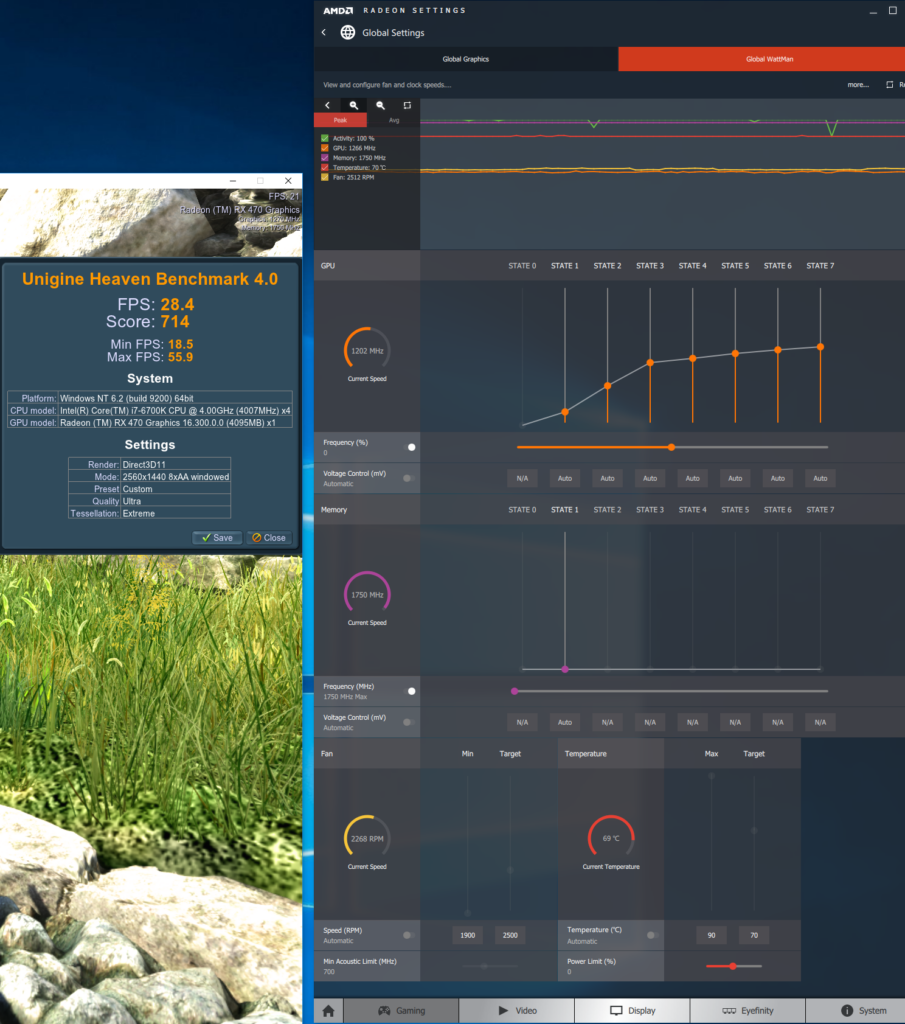
As you can see, the clocks are locked to 1206MHz or below and the temperature is 69C. Next we tried to overclock by 4%.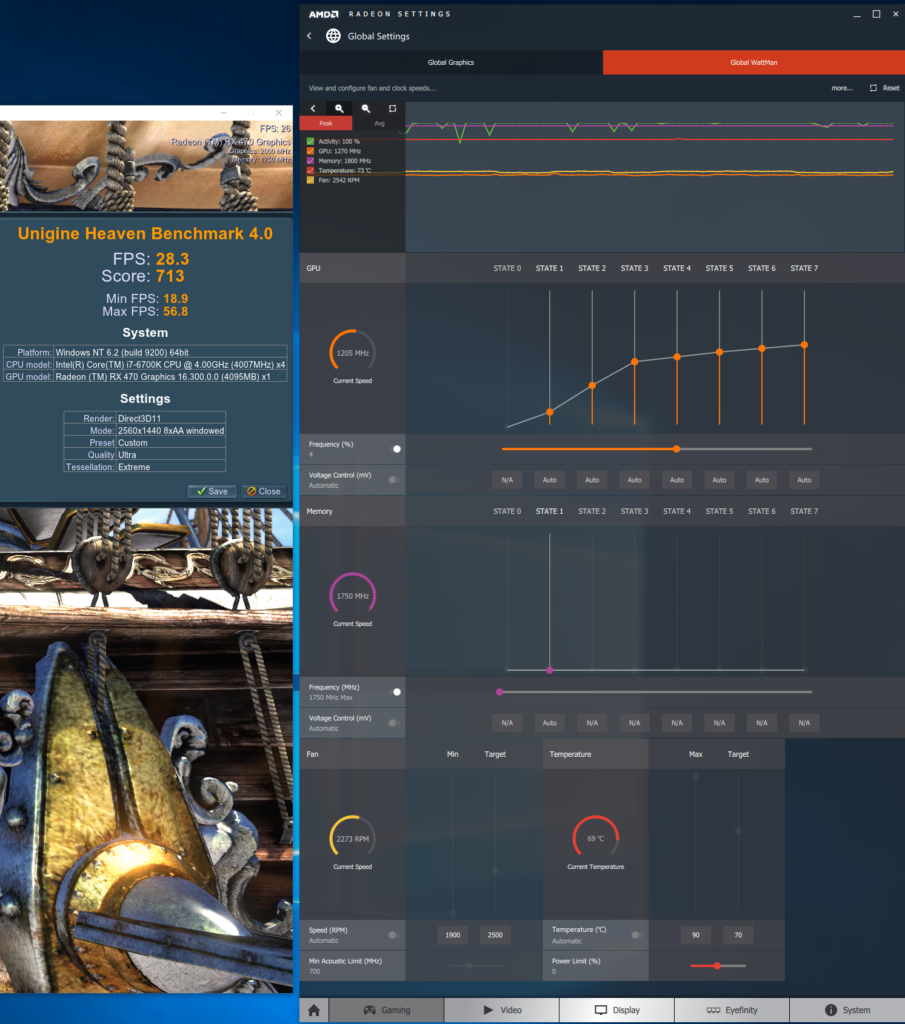
At the 4% overclock, nothing has changed. The clock speed still is below 1206MHz and the temperature is unchanged. And Heaven’s score is basically within 0.1 frame rate. So we decided to increase the fan speed and the temperature target and return to a 4% overclock as below.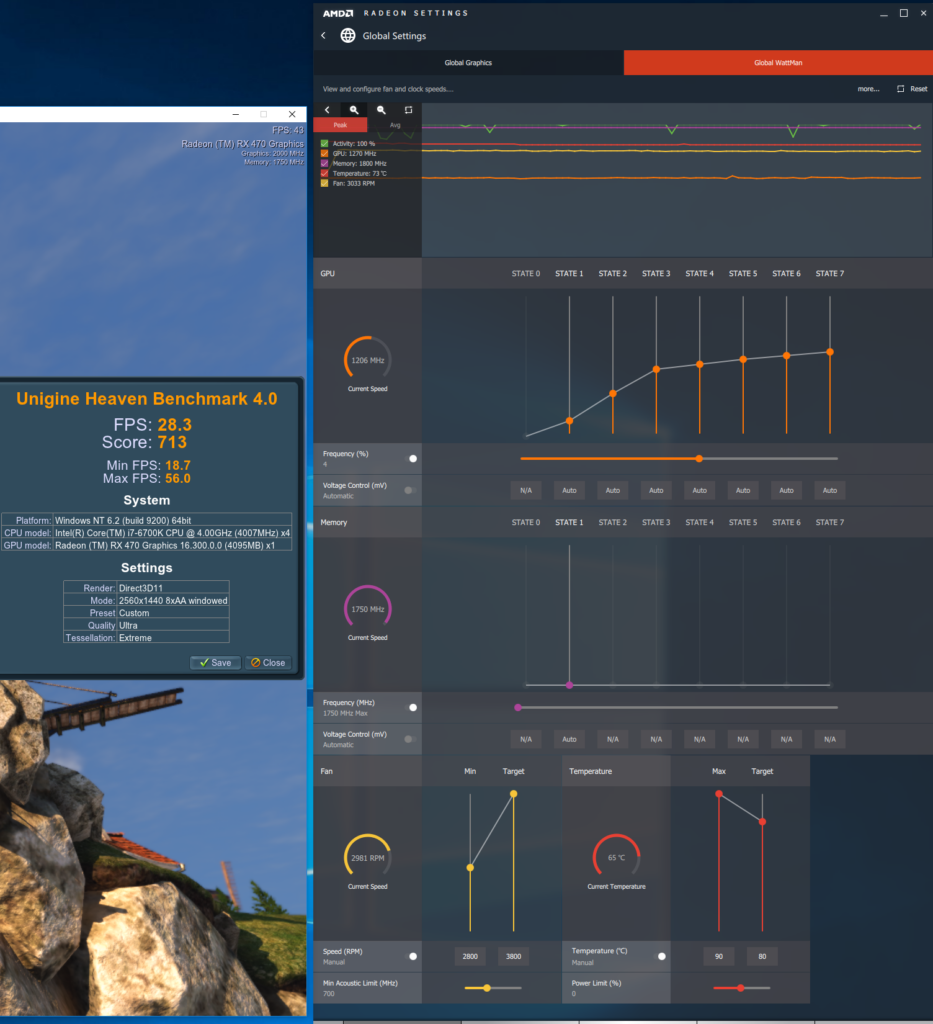
Well, with our 4% overclock and the temperature target and fan speeds increased, the temperatures dropped to 65C – so there was no throttling – but the Heaven score remained unchanged and clocks still stayed at 1206MHz instead of at PowerColor’s advertised 1270MHz. Although we had increased the fan speed, the Red Devil RX 470 remained very quiet.
GPU Z reported 1270MHz, but we realized clearly that something was wrong – right about the time that PowerColor sent us a belated new BIOS which we flashed yesterday afternoon using ATI Flash. Now we reran the same Heaven 3.0 benchmark with stock PowerColor settings after the BIOS flash as shown below.
The temperature jumps up to 79C, Heaven’s score increases by about 3% (which may have been held back by the higher temperatures throttling performance) and now we have the correct core boost – PowerColor’s 1270MHz boost clock. Unfortunately, PowerColor’s new BIOS came too late for us to run our 25 benchmark suite all over again and they will have to wait until a follow up evaluation.
Here is GPU Z that now matches what we see in practice. Strangely the BIOS Version remained unchanged but now our mystery of the locked clocks was solved.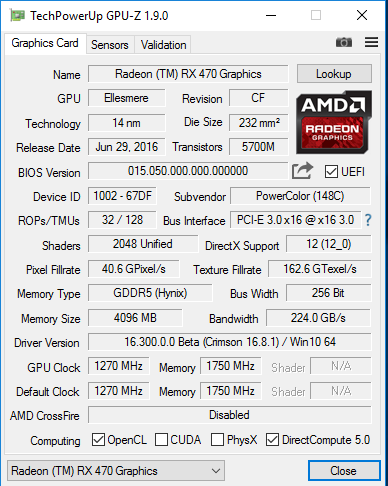 Let’s head to the performance chart to see how the PowerColor Red Devil at reference RX 470 speeds compares with its competing cards of Summer, 2016.
Let’s head to the performance chart to see how the PowerColor Red Devil at reference RX 470 speeds compares with its competing cards of Summer, 2016.
Performance summary charts & graphs
Here are our performance results of 25 games and 2 synthetic tests comparing the Red Devil RX 470 4GB at reference RX 470 clocks versus 5 other competing cards.
All results except for Firestrike and Time Spy are expressed in average fps (in Bold) and also generally in minimum fps (where they make sense, in smaller italics next to the averages). Each card is compared against the other in the adjoining results column at 1920×1080 and at 2560×1440 (if it is playable). ‘X’ means the test was not run and ‘NA’ means the test would not run or could not complete.
The first column represents the Red Devil RX 470 4GB, the second column has the reference RX 480 8GB results, the third column is the ASUS Strix GTX 960 OC 2GB results, the fourth column is the R9 280X, the fifth column represents the GALAX GTX 970 EXOC 4GB, and the final column is the Founders Edition of the GTX 1060 6GB at stock speeds.
We see the $199 Red Devil RX 470 come surprisingly close to the reference $239 RX 480 performance, often within about 10%. This is even more surprising when one considers that the Red Devil is running at stock RX 470 clocks! The GTX 960 OC is mostly outclassed by the RX 470, held back by its 2GB of vRAM. The 280X is easily beaten by the RX 470, and the GTX 970 OC and GTX 1060 although they are generally faster, are in a higher price range ($250 plus).
Let’s head for our conclusion.
The Conclusion
The Red Devil RX 470 does surprisingly well considering that it was held back in our testing by its original BIOS which limited it to reference RX 470 clocks. It beats the R9 280X and the price-competitive GTX 960 handily and comes rather close to stock RX 480 performance. Considering that the Red Devil is PowerColor factory clocked 64MHz higher than the stock RX 470, it is easy to see that its performance will come much closer to the reference RX 480. However, we will have to wait until next week to see just how close it comes and if it can overclock further. And WattMan brings some nice features that we would like to use for fine tuning the PowerColor Red Devil RX 470 overclock.
Let’s sum it up:
PowerColor Red Devil RX 470 Pros
- The PowerColor Red Devil RX 470 comes very close to RX 480 performance even though it was held back to RX 470 reference clocks and it beats the competition’s GTX 960 rather handily.
- At $199 the Red Devil RX 470 is only $20 more than the reference RX 470, and it offers a DVI-D input and a nice backplate plus improved power delivery for better stability and overclocking potential with an 8-pin PCIe connector. It is also $40 less expensive than the reference RX 480.
- The Red Devil is clocked higher than the reference RX 470 and it will narrow the gap further with the more expensive RX 480 reference version.
- The Red Devil RX 470 has a very nice 2-fan custom cooling design that is very quiet.
- WattMan brings new features to Radeon overclocking that was not present in OverDrive.
- RX 470 is a fast midrange card and its power draw is only 120W, 30W less than the reference RX 480.
- New features in Polaris architecture improves on Async compute with dedicated hardware and the Red Devil RX 470 may even be well-suited for VR.
- FreeSync eliminates tearing and stuttering.
PowerColor Red Devil RX 480 Cons
- The original shipping performance BIOS of the PowerColor Red Devil RX 470 was locked to stock RX 470 clocks and we simply did not have time to retest it
We cannot comment on PowerColor’s higher than reference clocks as we did not test it yet. The Red Devil may be a very good deal for those who game at 1080P, and it may be an excellent alternative to the reference RX 480 with its higher power requirements and limiting 6-pin PCIe connector.
The Verdict:
- The PowerColor Red Devil RX 470 is new architecture on a new process that uses significantly less power and has more refinements than AMD’s last generation. It is solidly built and it has higher clocks out of the box than the reference RX 470 which has only a 6-pin PCIe connector. It represents a solid value at $199 in our opinion and it deserves BTR’s Good Value Award – even at reference RX 470 clocks!
We do not know what the future will bring, but right now, the PowerColor Red Devil RX 470 brings solid improvement over AMD’s last generation and it also beats the competing GeForce cards in the same price range while coming very close to reference RX 480 performance for $40 less.
It will be interesting to see if Nvidia responds soon with their own “GTX 1050” card, or with price cuts on their current line up.
Stay tuned, there is a lot coming from us at BTR. Next up we will continue with our Pascal TITAN X series with Part 2 due on Friday. We will use our entire 25 game benchmark suite to compare it with GTX 1080 performance using 4K, 2K and 1440P resolutions.
Happy Gaming!
Mark Poppin
BTR Editor-in-Chief
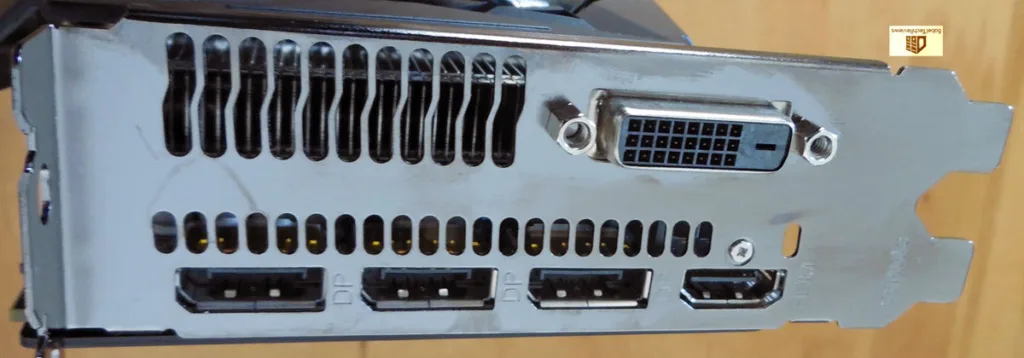
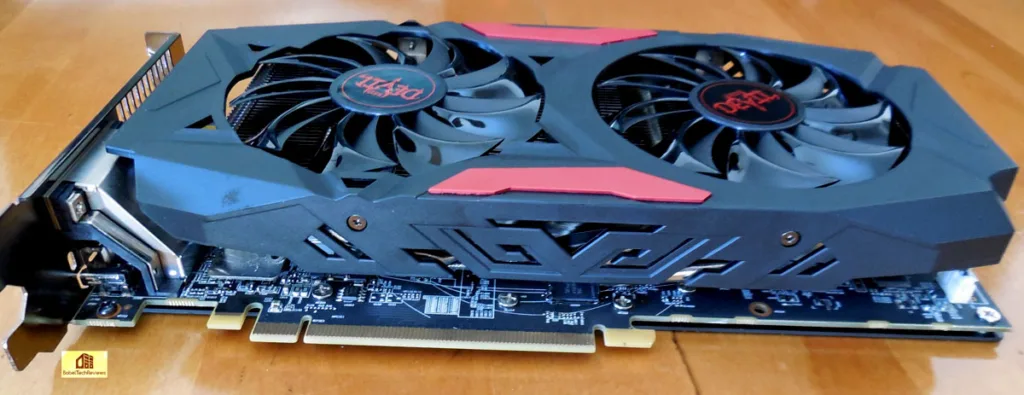
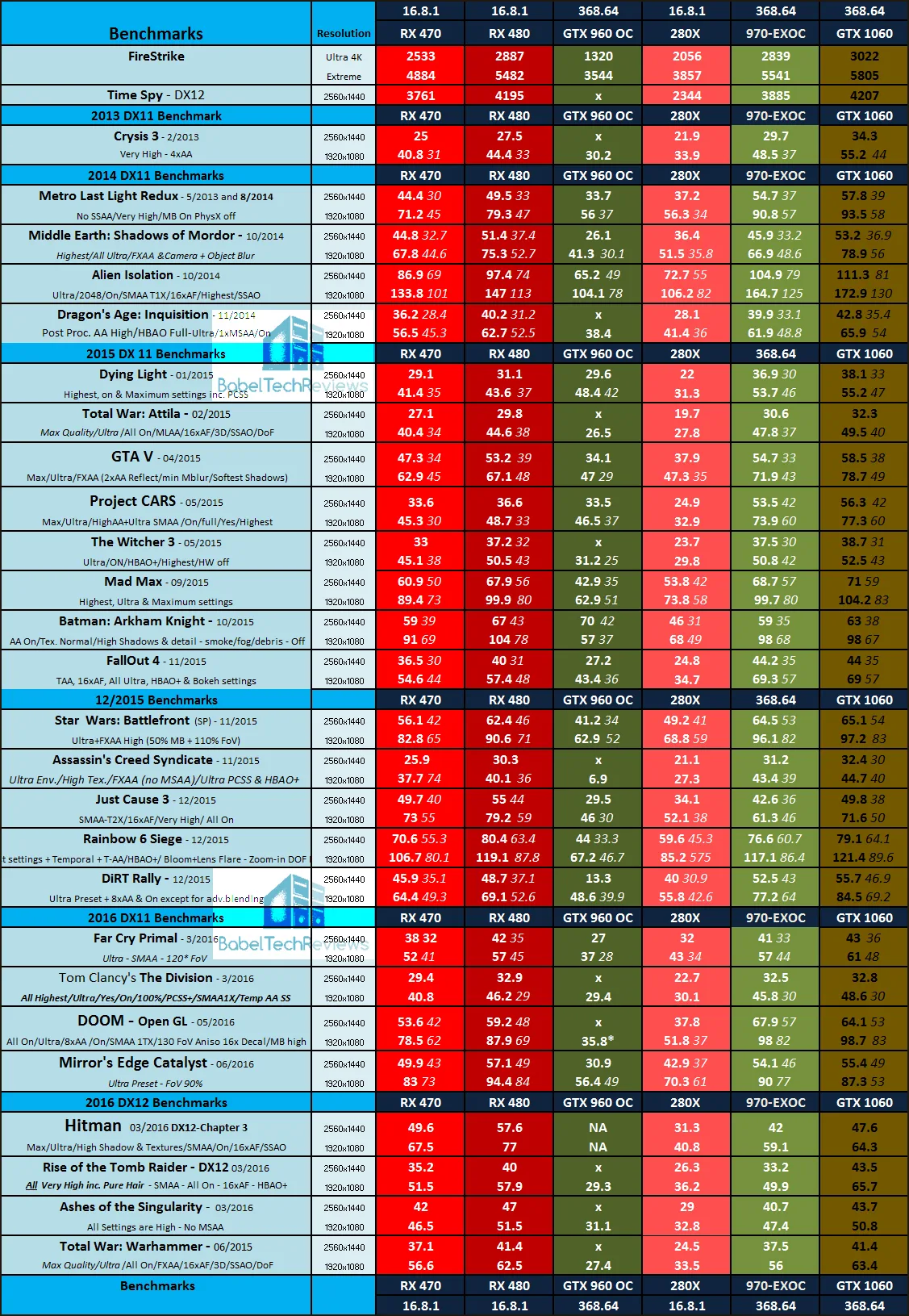
Comments are closed.